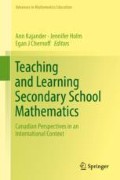Abstract
In this chapter, we consider the images, meanings, and metaphors provoked by the phrase in the title of the opening section of the book: The Changing Landscape. Inspired by our Indigenous and ecological sensibilities, we develop new images, meanings, and metaphors that illuminate the collective nature of secondary mathematics classes. We explore the Pirie-Kieren (1989) model in terms of how it relates to the collective level of the class. Using a video based excerpt from a secondary mathematics class, we map the observed ideas onto the Pirie-Kieren model as they emerge and evolve, moment to moment. The results reveal a dynamic ideational topography of the classroom. Through illustrative exemplars and the analyses that accompany these, we reflect on how paying attention to the ideas of the class as live(d) topographies occasion new questions for further investigation into mathematics classroom collectives.
Access this chapter
Tax calculation will be finalised at checkout
Purchases are for personal use only
References
Bateson, G. (1972). Steps to an ecology of mind. New York: Ballantine.
Christopherson, R. W. (2002). Geosystems: An introduction to physical geography (4th ed.). Upper Saddle River: Prentice-Hall.
Davis, B., & Simmt, E. (2003). Understanding learning systems: Mathematics education and complexity science. Journal for Research in Mathematics Education, 34, 137–167.
Jardine, D. W. (2003). On the nature of inquiry: Choosing a topic. Retrieved from http://galileo.org/teachers/designing-learning/articles/choosing-a-topic/
Katz, C. (2001). Vagabond capitalism and the necessity of social reproduction. Antipode, 33(4), 709–728.
Kieren, T., & Simmt, E. (2002). Fractal filaments: A simile for observing collective mathematical understanding. In D. Mewborn, P. Sztajn, D. White, H. Wiegel, R. Bryant, & K. Nooney (Eds.), Proceedings of the 24th annual meeting of the North American chapter of the International Group for the Psychology of Mathematics Education (Vol. 2, pp. 865–874). Columbus: Eric Clearinghouse for Science, Mathematics, and Environmental Education.
Landscape. (2017). In English Oxford living dictionaries. Retrieved from https://en.oxforddictionaries.com/definition/landscape
Martin, L. C., & Towers, J. (2003). Collective mathematical understanding as an improvisational process. International Group for the Psychology of Mathematics Education, 3, 245–252.
Martin, L. C., & Towers, J. (2015). Growing mathematical understanding through collective image making, collective image having, and collective property noticing. Educational Studies in Mathematics, 88(1), 3–18.
McGarvey, L., Davis, B., Glanfield, F., Martin, L., Mgombelo, J., Proulx, J., Simmt, E., Thom, J. S., & Towers, J. (2015, November). Collective learning: Conceptualizing the possibility in the mathematics classroom. Discussion group at the 37th annual meeting of the North American chapter of the International Group for the Psychology of Mathematics Education, East Lansing, MI.
McGarvey, L., Glanfield, F., Mgombelo, J., & Thom, J. S. (2017, April). Monitoring the vital signs of classroom life. Research symposium at the 2017 National Council of Teachers of Mathematics research conference, San Antonio, TX.
National Council of Teachers of Mathematics (NCTM). (2014). Principles to action professional learning toolkit: Bike and truck. Retrieved from http://www.nctm.org/PtAToolkit/
Papert, S. (1980). Mindstorms: Children, computers, and powerful ideas. New York: Basic Books.
Pirie, S., & Kieren, T. (1989). A recursive theory of mathematical understanding. For The Learning of Mathematics, 9(3), 7–11.
Pirie, S., & Kieren, T. (1994). Growth in mathematical understanding: How can we characterise it and how can we represent it? Educational Studies in Mathematics, 26(2–3), 165–190.
Thom, J. S., & Pirie, S. E. (2006). Looking at the complexity of two young children’s understanding of number. The Journal of Mathematical Behavior, 25(3), 185–195.
Walter, E. V. (1988). Placeways: A theory of the human environment. Chapel Hill: University of North Carolina Press.
Acknowledgements
This work has been supported by a research grant from the Social Sciences and Human Research Council (SSHRC).
Author information
Authors and Affiliations
Corresponding author
Editor information
Editors and Affiliations
Rights and permissions
Copyright information
© 2018 Springer International Publishing AG, part of Springer Nature
About this chapter
Cite this chapter
Thom, J.S., Glanfield, F. (2018). Live(d) Topographies: The Emergent and Dynamical Nature of Ideas in Secondary Mathematics Classes. In: Kajander, A., Holm, J., Chernoff, E. (eds) Teaching and Learning Secondary School Mathematics. Advances in Mathematics Education. Springer, Cham. https://doi.org/10.1007/978-3-319-92390-1_6
Download citation
DOI: https://doi.org/10.1007/978-3-319-92390-1_6
Published:
Publisher Name: Springer, Cham
Print ISBN: 978-3-319-92389-5
Online ISBN: 978-3-319-92390-1
eBook Packages: EducationEducation (R0)

